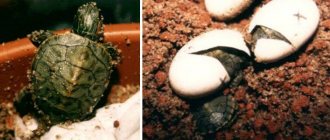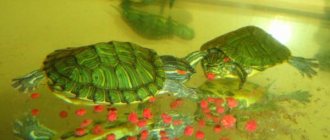Red-eared turtles are amazing and funny creatures that today are found not only in the natural environment, but also in many home aquariums. The popularity of these pets is only increasing over time. They are cute, cheeky, lively, and are not averse to quarreling with their relatives and putting on a hilarious face. Of course, reptiles differ from the more common pets - cats, dogs, parrots; they require special conditions of maintenance and nutrition. In addition, they raise a lot of questions among novice owners, for example, it is not always clear why they behave one way or another, and even the sexual difference of individuals often remains in question . How to determine the sex of red-eared turtles, what to look for?
When it becomes clear - a boy in the aquaterrarium or a girl
Unfortunately, it is not so easy to distinguish a male red ear from a female, and even a specialist will not be able to select babies of the desired sex among the young animals. More or less obvious signs appear only during puberty of individuals.
Red ears can reproduce from 6-8 years of age; it is during this period that sexual differences are most noticeable. But indirect signs are also present in 1.5-2 year old turtles, and if you compare them all, you can find out the sex of your pet.
An owner who is tormented by the question of the sex of a reptile living in his aquarium should pay attention to a number of physiological characteristics of these reptiles.
Adviсe
- Sex can be recognized after puberty.
- A reliable option would be to make comparisons across multiple animals. Sometimes some signs are similar in turtles of different sexes. It is better to check pets based on several factors.
- Living conditions in animals sometimes cause hormonal imbalance. Then only a veterinarian can determine the sex.
Previous
InhabitantsGetting rid of food debris using the ampullaria snail
Next
InhabitantsWhat to feed omnivorous and herbivorous land turtles at home?
Claw length
Males of this breed, however, like most representatives of other varieties of turtles, have forelimbs equipped with elongated claws. Females also have them, but their length is much more modest, and there are no points at the ends. The male uses them during mating, holding the female with them, eliminating the possibility of slipping.
There is one caveat - when living in an artificial tank, a turtle can grind its claws on an island of land. In this case, it all depends on the material from which this section is made.
Determining age by rings
Another way to find out the age of a red-eared slider is by the appearance of new rings in the pattern of its shell. The first of them form before she is a year old, and after that new ones appear, two or three annually. Again, the method suffers from inaccuracy. Of course, after observing your pet for a year or two, you can calculate by how much the number of rings increases and estimate the age based on the existing ones. But! The formation of such patterns very much depends on the conditions in which the turtle lived before you. Even hibernation or lack thereof can significantly affect the rate of formation of new patterns. The tightness of the home, the quantity and quality of food, the temperature in the house are all factors that influence the development of rings. Although it will still be possible to establish an approximate age with an error of 5-6 years.
Features of the carapace
When determining the sex of a reptile, you can also take a closer look at the armor in which its body is packed. In order for the fertilization process to proceed most successfully, in males the surface of the plastron - the abdominal shield - has a slight concavity. Females do not have this sign.
There are also differences in the shape of the carapace - in males it is more oval, elongated, and in the area of the tail resembles a pointed tick. In females, part of the shell at the tail is rounded; here you can see a decent-sized hole, necessary for the trouble-free laying of eggs.
Diseases of aquatic reptiles and preventive measures
If you provide the marsh turtle with decent living conditions, you can avoid any problems with its health. She has strong natural immunity and high vitality. Most turtle illnesses are associated with improper housing conditions or poor care. More often than others, the following diseases and pathologies are detected in freshwater reptiles:
- A cold is the result of cooling or keeping your pet in a draft. It manifests itself in the form of irregular, difficult breathing, the appearance of mucous discharge from the nasal passages and oral cavity. The turtle begins to wheeze, refuses to eat, and moves little.
- Rectal prolapse or prolapse of the cloaca (cloacitis) - pathology can occur due to various reasons. Most often it develops against the background of helminthic infestation or prolonged diarrhea. The turtle's cloaca is visible, soil and debris stick to it, and the front limbs may swell.
- Diarrhea - in most cases, is the result of eating low-quality or stale food.
- Nematodosis and cestodosis - tapeworms and roundworms enter the reptile's body from food that has not undergone heat treatment.
- Intestinal obstruction - the main cause is associated with the ingestion of foreign objects - small pebbles, sand, debris. Rarely manifests itself in the form of vomiting, shortness of breath, and neurological disorders.
- Paralysis of various origins.
- Violation or delay in egg laying - a turtle can carry its offspring beyond term due to a narrowing of the birth canal, large egg size, lack of a ready-made nest, and other reasons.
- Infection with ectoparasites - creatures that parasitize the outer surface of the reptile.
In addition, when home furnishings are violated, residents are often injured and their skin is damaged. Often, inexperienced owners of marsh reptiles make a number of mistakes when keeping their pets, which leads to deformation of the armored scutes. More often, this occurs as a result of a deficiency of vitamin components and calcium during the period of active growth and puberty of the individual.
Other sexual characteristics
If turtles of the same age live in the same tank, then it is worth trying to find out the gender of the reptiles based on their size. Females are larger individuals - nature made sure that they could bear offspring and make a full clutch.
Experienced breeders or zoologists are able to distinguish between boys and girls by their muzzle - in the male it is more elongated, and in the female it is blunt, with smooth, rounded lines. Naturally, we are talking about an indirect sign that an ignorant person is unlikely to notice. On the limbs of males you can find noticeable spurs on the hips, which indicates their strength and stability when compared with the legs of females.
Relationship between age and red spots
The most likely place to purchase a turtle for a home pond is a pet store, where the seller, among other data, must tell you the age of the reptile being purchased.
However, you, as the future owner, also need to navigate this issue, since reptiles of different ages feed differently and require different care, and having at least basic information about the future pet will be very useful.
So, the red-eared turtle is called due to the presence of red spots behind its eyes, which, in general, are in no way connected with the hearing organs.
Over the course of a turtle's life, as it grows, these spots change their color saturation from scarlet to burgundy.
The green carapace of the red-eared reptile with stains and stripes at a younger age becomes darker and duller as it ages.
An important indication of the age of a red-eared turtle can be the size of its carapace. But here it should be taken into account that in comfortable conditions a pet can grow at an accelerated pace, and there are many subspecies of red-eared reptiles, and not all of them have the same shell length/age ratio.
So how can you determine the age of your red-eared pet as reliably as possible?
The most accessible to a non-specialist for determining the age of red-eared reptiles are several methods - by the length of the carapace and the pattern on it, by its color and shape.
Behavioral features
Most animals change their character during mating, and red-eared turtles are no exception. By some habits you can understand which sex a particular individual belongs to. First of all, at this time the males perk up, become more active and mobile. How else? After all, the primary task is to attract the attention of a female who is ready to mate. To do this, they stage real performances demonstrating their own capabilities and advantages.
If an individual begins to wave its front legs with long, large claws in front of another turtle, then there should be no doubt that this is a male. In addition, gentlemen at this time become incredibly intrusive and literally do not allow the “brides” passage, while making enticing, playful head movements.
Differences between a male and a female
- Size . This method is only suitable if there are 2 turtles of the same age, for example from the same offspring. Gender can be determined by their size. The female will be larger than the male. This is due to the fact that the female needs to bear and lay eggs.
- Carapace . To determine sex by the shape of the shell, the turtle must be turned belly up. In males, the lower part is long and elongated, shaped like a V at the tail. The plastron (the abdominal shield of the shell) will be slightly concave. This shape helps the males stay on the female’s shell at the time of fertilization. Females have a wide plastron with a smooth surface.
- Claws . The male's claws are long and sharp. He needs this feature in order to stay on the female’s shell at the time of fertilization. But it is worth considering the conditions of keeping turtles. It is necessary to install an island in the terrarium where turtles can crawl out and bask under a lamp. You need to pay attention to the material from which the dry land is made, as turtles quickly wear down their claws on it. Females will have blunt and short claws, since they do not need such a length. Males will also have more pronounced femoral spurs on their paws and will have small scales on their hind paws.
- Red stripe on the head . The red-eared turtle has a red stripe on its head. In males it is much brighter and clearer than in females.
- Tail . The tail can be used to determine sex even if there is no second individual for comparison. In males, the tail is long and wide, since it houses the genital organ. In females, the tail is short and even, without thickening at the base.
- Hole . The female has a hole in the tail area through which she lays eggs. Accordingly, males do not have such a hole.
- Cloaca . The older the turtle, the more accurately the sex can be determined by the location of the cloaca. In females, the cloaca is located close to the shell, almost at the very base, and has the shape of an asterisk. In males, the cloaca is located at a considerable distance from the shell, almost at the edge of the tail, and looks like a transverse line. The older the turtle, the longer the tail on which the cloaca is located, and accordingly, the more accurate the result will be.
- Muzzle . The most inaccurate way to determine sex, which you shouldn’t rely too much on, since all turtles are individual and have their own characteristics. It should only be taken into account in conjunction with other characteristics. Males have a muzzle that is more elongated and pointed at the end; females have a wide, rounded muzzle.
- Mating season . Red-eared turtles live on average 20-25 years at home. Males become sexually mature at the age of 4-5 years, and females are ready to breed somewhat later, at the age of 5-6 years. During the mating season, gender can be determined most accurately. The behavior of males and females is significantly different. The activity of males increases significantly, they begin to attract females to mate. Males chase females, waving their paws with long claws, nod their heads in a funny way, and may lightly bite the female on the neck.
- Behavior . To determine the sex of a turtle by its behavior at normal times, you need to observe it for several days in a calm environment. Males are somewhat more active. They often swim and often crawl onto land to bask. Females sit on land for a long time or swim for a long time. Males also behave more aggressively and can bite. Females bite only in exceptional cases.
To most accurately determine the sex of a red-eared turtle, you need to wait until it becomes sexually mature. Then the differences between the male and the female will be clearly expressed. If the turtle is less than 5 years old, and there are plans to breed turtles in the future, then it is better to seek the help of a specialist.
If the sex is determined incorrectly, and therefore the pair is incorrectly selected, the owner will have to support two same-sex individuals. And if the females are more relaxed about the second individual in the terrarium, then the two males will share the territory and may injure each other.
It doesn’t matter what gender or age the red-eared turtle will be. The main thing is to provide the turtle with comfortable living conditions and prepare the right diet. Only in this case will the red-eared turtle be active and healthy, and live as long as possible.
TYPES OF SNAKES: CHARACTERISTICS AND STRUCTURE, LIFESTYLE
GYURZA SNAKE: TYPES, DESCRIPTION, PHOTO, NUTRITION, POISON, REPRODUCE, FEATURES
CAUCASIAN VIPER: DESCRIPTION AND PHOTO
CURRENT GECKO KEEPING AT HOME, PHOTO
What to feed the red-eared slider
As for young turtles, they need animal food for active vital growth of the body. In this regard, it should be given once a day, but no more. Also, the aquarium should have various algae and any other plants that are edible for turtles.
Adult turtles are individuals that are much larger than 12 centimeters. They must eat food once every two or three days and half of their diet must be some kind of vegetation. The aquaterrarium should contain any edible plants so that the turtles can eat them between meals.
The amount of food given is determined based on the size of the turtle. For kids, the norm is two or three pieces of one cubic centimeter, and for older turtles - two or three pieces several times larger in size.
It is necessary to ensure that the food is at a suitable room temperature and must have a raw consistency.
It is important to remember that young turtles are, first and foremost, predators. Their main food is fish. You can add live fish to the aquarium that they cannot eat.
It is necessary to diversify the diet given and not feed only gammarus and dry food. And adult turtles are omnivores. They eat both animal and plant food
You can add live fish to the aquarium that they cannot eat. It is necessary to diversify the diet given and not feed only gammarus and dry food. And adult turtles are omnivores. They eat both animal and plant food.
Types of feed
As for fish, it is useful for turtles to eat pollock, gobies, cod, blue whiting and any other fish, but not fatty ones. The liver can be beef, or you can also give liver or chicken heart. From insects and crustaceans: non-dry gammarus, earthworms, daphnia crustaceans, legless crickets, beetles. You can diversify the food served to them with the help of small snails, mollusks, squids, frogs, small tadpoles; you should not get carried away with seafood, since any turtle is itself a sea turtle. Aquatic plants are not prohibited from plant food: duckweed, hyacinth and others. In addition, it can be dandelion, daisies and any non-poisonous meadow flowers and plants. It is not advisable to give vegetables other than carrots and lettuce.
It is strictly forbidden to give turtles any meat: any minced meat, sausages, beef, sausage, lamb, chicken, pork, etc. Fatty fish, cheese, fruit and bread are prohibited. It is better to avoid dry food.
If the aquarium is well equipped, has ultraviolet lighting, and appropriate temperature conditions, then vitamins may not be included in the diet. But, in the case when the conditions are far from ideal, it is necessary to remember about the vitamin and mineral base. Vitamins are already included in the food specifically for this purpose.
Second way
The reptile's shell represents its unique passport, provided that it was provided with good care, properly fed and provided with enough living space.
In this case, the concentric rings on the carapace will indicate a certain number of years she has lived. These rings first appear on the turtle’s shell when it reaches one year of age, and for the first two years of its life, the grooves of the rings are marked quite dynamically, adding two or three every six months.
To do this most accurately, you need to count the number of rings in different parts of the carapace and display the average result.
MEET YOUR PET
Red-eared turtles are easy to care for and therefore are recommended for those who first decided to have reptiles. Red-eared turtles are a freshwater species. They live about 30-40 years. The length and shell can reach 18-30 centimeters.
The shell of turtles is olive or yellowish-brown in color. In young individuals it may be deep green.
The turtle's head and neck are covered with white and green stripes and spots. But they owe their name to two spots extending from the eye area. They have an orange-red tint.
The red-eared turtle comes from America. Its natural habitat is all of Central America and the northwestern part of South America. The species was also introduced into Israel, South Africa, Guadeloupe and other European countries, where it successfully took root.
Find out how long ferrets live at home if you feed them properly, maintain them, and treat them promptly.
And this publication tells how long a chinchilla can live at home.
How long a pet hamster will live with proper care is described here.
The amphibian lives in small swampy bodies of water: lakes, ponds. Turtles are inactive, but curious. Their favorite pastime is lying in the warm sun.
The red-eared turtle has well-developed vision and sense of smell, but the hearing and vocal cords of this amphibian are poorly developed. The turtle can only hiss or snort when excited and irritated. Possessing strong jaws, the red-eared turtle can seriously injure a person or other pet if it is in danger.
Video: find out the gender
When can it be determined?
Turtles live a long time, so they acquire both young and adult individuals. Determining gender at a young age (before reaching the age of puberty) is almost impossible. Therefore, in order to correctly and reliably determine the sex, it is necessary to wait until the turtle is five to eight years old.
What conditions should be created for a pair of turtles?
Thus, we found out how to determine the sex and age of red-eared turtles. Selecting an adult male and female for keeping at home will not be difficult. But getting offspring from red eareds in captivity, even if the aquarium contains guaranteed individuals of different sexes, will still be quite problematic. These turtles lay their eggs not in water, but on land, burying them in the sand.
But be that as it may, the conditions for a couple of turtles in the aquarium, of course, should be created decent. In this case, a container for keeping reptiles should be purchased with a volume of at least 150 liters. For each turtle, you need to provide its own raft with suction cups and a stand. An incandescent lamp and a UV lamp should be placed above the rafts to create a comfortable temperature.
If the owners of turtles still expect to get offspring, in the aquarium, among other things, they will need to place a cuvette with sand or peat. Such a container should be installed so that the female can easily climb into it. Layed red ear eggs can then be incubated in a regular chicken apparatus at a temperature of 22-30 °C.
- These are terrarium pets that do not require complex knowledge in care and maintenance at home. But the difficult part is determining the sex of the red-eared turtle, because you need to make sure that it is a boy and a girl.
At an early age, it is difficult to determine the female. Red-eared turtles reach maturity only at 7–8 years after birth, when characteristic signs begin to clearly appear and it becomes easier to determine the sex of the baby.
Article information
Pets
In other languages:
English: Tell If a Turtle Is Male or Female, Español: saber si una tortuga es hembra o macho, Deutsch: Das Geschlecht einer Schildkröte bestimmen, Português: Saber Se uma Tartaruga É Macho ou Fêmea, Italiano: Capire se una Tartaruga è Maschio o Femmina, Français: déterminer le sexe de votre tortue, 中文: 区分乌龟的性别, Nederlands: Het geslacht van een schildpad vaststellen, 日本語: カメの性別を見分ける, : Čeština: Jak poznat, zda je želva samec či samice, Bahasa Indonesia: Membedakan Jenis Kelamin Kura Kura, Tiếng Việt: Nhận biết Rùa Đực và Rùa Cái, Türkçe: Bir Kaplumbağanın Erkek Veya Dişi Olduğu Nasıl Anlaşılır
This page has been viewed 91,030 times.
Reproduction
The breeding season for red-eared turtles that live in the Southern Hemisphere is from September to December, and those that live in the Northern Hemisphere is from April to June. As a rule, mating occurs under water. They build their cozy nests on the sand near the water, in places shaded by plants, so as not to overheat. Male pet turtles reach sexual maturity at 4 years, females at 6 years. The mating period at home is from February to May. After mating, the female comes to land to lay eggs.
Therefore, it is very important for these animals to create appropriate conditions in captivity. Small turtles are born after 105-150 days; the ambient temperature should not fall below 21 degrees. The length of the cubs is 3 cm
The length of the cubs is 3 cm.
Offspring are born during the rainy season, which lasts from September to December in areas north of the equator, and in June in areas south of the equator.
Interesting: What causes a snail's shell to crack?
Caring for a red-eared slider
They, like other predators, feed mainly on protein foods, for example, small worms, bloodworms or crustaceans are suitable for babies. But stronger turtles can eat cockroaches, snails, crickets, and earthworms.
Beef liver, liver or chicken hearts are also suitable. The fish should be cut into small ribbons and scalded with boiling water. Under no circumstances should you give minced meat, sausages, sausage, cheese or bread.
In addition to meat, it is necessary to add lettuce, cabbage or seaweed to the diet to avoid the development of diseases.
At a young age, the red-eared turtle needs to be fed daily; adults feed once every 2-3 days. Turtles are very active during the day, so feeding should be done at the same time.
If it is impossible to install ultraviolet lamps, it is advisable to place the turtle in the sun near a water tank, avoiding direct rays.
Under ideal conditions, the presence of ultraviolet lamps and compliance with the temperature regime, the vitamin complexes included in the feed do not need to be used.
Criteria for determining the sex of turtles
| Criterion of difference | Male | Female |
| Claws | Thick and long | Thin and short |
| Cloaca shape | Longitudinal strip | Star shape |
| Plastron | Concave | Flat |
| Tail | Long, thick; base – wide | Short; base – thin |
| Behavior | Active, pugnacious during mating season | Passive |
In any case, whether the turtle is a boy or a girl, the reptile must please its owners. It's no secret that children in particular are delighted with these adorable reptiles. Still, it is clear that there is no point in having a pet that does not bring pleasure.
veterinarian - the answer will be sent to your email











